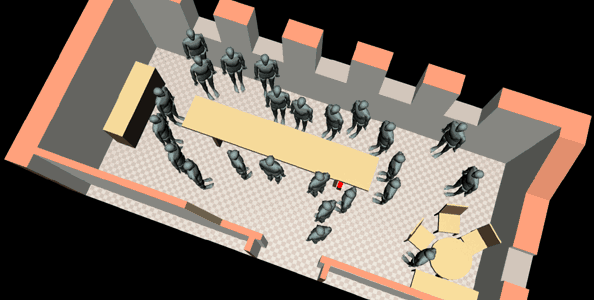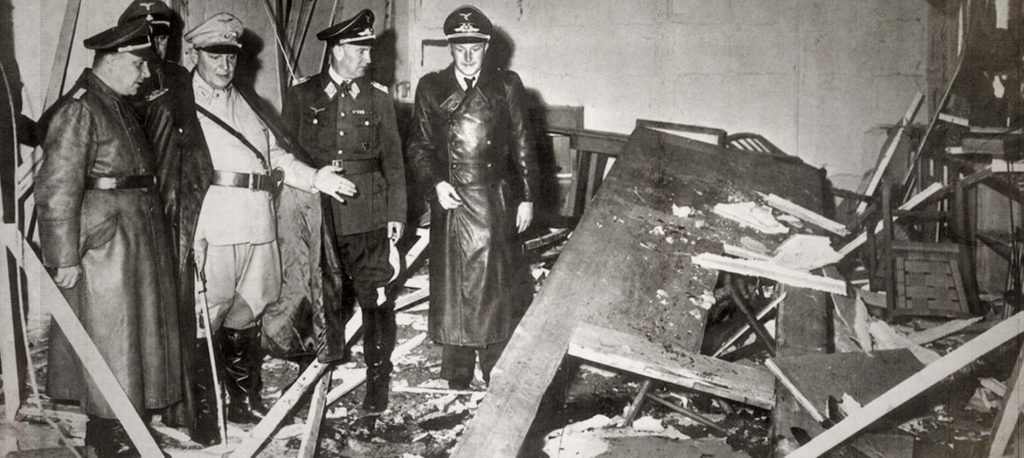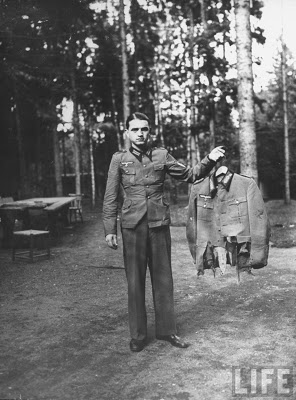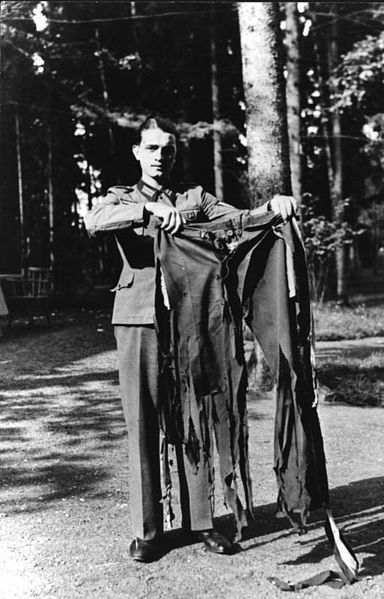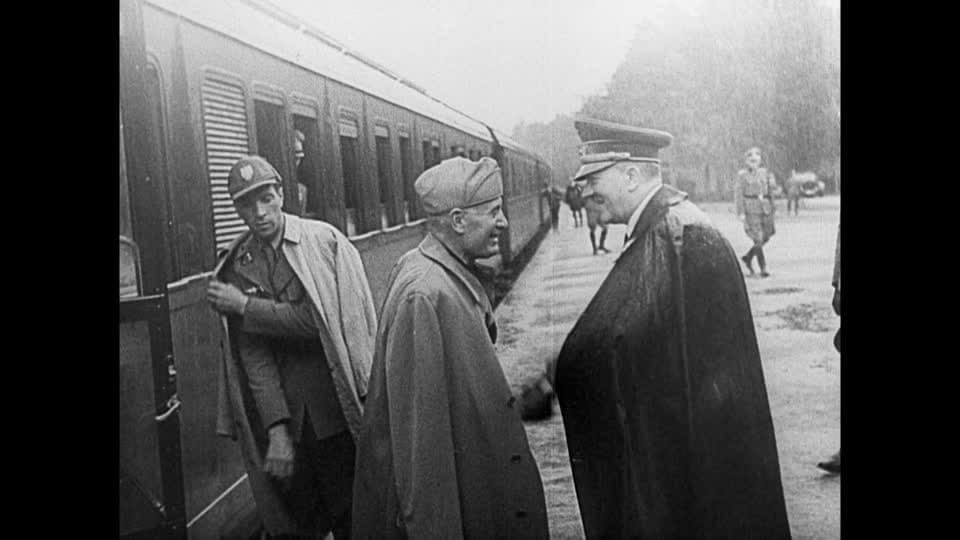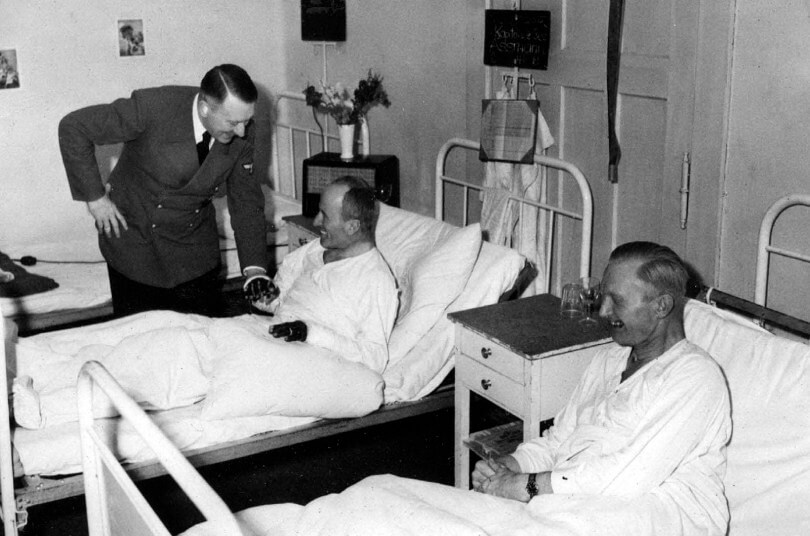Operation Valkyrie:
a plot to kill Adolf Hitler
20th July 1944
The prolonging war with the Soviet Union, failures on the Eastern Front, the increasing problems with food and air-raids on German cities since the summer of 1942 caused accumulating pessimistic moods among the civilian population. After the Staliningrad defeat this situation transformed into more or less active resistance which began to spread among wider and wider circles of society.
Senior officers had most opportunity to fight with the regime. Under certain circumstances they could use the armed forces in order to make the transformation in the country. The military opposition group became more active when the members established contacts with Leipzig Carl Friedrich Goerdeler and General Ludwick Beck who became the leading opposition representatives in both civilian and military circles of society. However, disputes about the place, time and manner of the coup’s implementation had to be stopped because of the tragic situation on the frontline.
On 4 June 1944 Rome was independent again, two days later English and U.S. troops landed in Normandy . At the beginning of July great areas of the USSR had been liberated and the Red Army entered Poland. A new person appeared on the political stage: Colonel Claus Schenk von Stauffenberg. He took on the risk of the attack on Hitler and guiding the transformation in the country. Preparations for take-over based on the plan under the cryptonym “Valkyrie“, which was provided in case of a possible prisoners’ and forced laborers’ rebellion in Germany, were made. Approved by Hitler, the plan was to serve as legal basis for the beginning of the intended military coup. With the help of the army (ready to stifle a possible rebellion), under Colonel Claus Schenk von Stauffenberg they planned to take over district government , the ministry of propaganda, all the important facility missions, the radio, press and to arrest officers.
Stauffenberg’s assassination attempt on Hitler:
the bomb.
Stauffenberg along with his adjutant Werner von Haeftenem appeared in Wolf’s Lair in the morning of July 20. Their plane from Berlin landed near headquarters at about 10.15. Stauffenberg announced that he wished to refresh himself and change his shirt. John von Freyend made his room available to him. Haeften came together with Stauffenberg to the designated area to help and prepare explosives.
Each explosive (made in England) had a single chemical starter working with a 10-minute delay. Getting detonators working turned out to be quite complex and lengthy. “It was necessary to first press copper scales which consisted of glass ampoules with acid. Acid had to destroy the wires in a specified time, tensioning spiral feathers with starter pins. It had to be done very carefully in order not to press the tensioning wires. Then checking whether the detonators were still tight was done through a hole and then the fuse was removed and the starter inserted.“
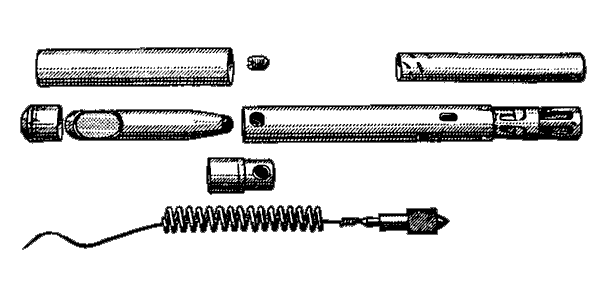
A few minutes before 12.30 Stauffenberg went to the barrack for the meeting. On the way John von Freyend offered to help Stauffenberg carry the briefcase, but the colonel refused. However, just in front of the barrack he passed the briefcase to him, wanting it to be as near Hitler as possible. They came to the barrack when the General Heusinger was discussing the situation on the Eastern Front. John von Freyend asked Admiral Voss to move to other side of the table to make place for Stauffenberg. The briefcase with explosives was placed outside the right bracket table at a distance of about 2.5 – 3 meters from Hitler. After several minutes had passed Stauffenberg announced that he had to make a phone call. The phones were in a neighbouring room. His adjutant went with him. At the time when Stauffenberg and his adjutant got into the car the explosion shook the ground.
Driving near the barrack they saw clouds of smoke, charred papers rotating in the air, injured and running people. They managed to leave the zone without difficulty: the car’s passenger was a widely recognized person – his military career, wounds from Africa and position made him highly respected. At 13.15 they flew away back to Berlin. Stauffenberg and Haeften landed in Berlin convinced of the success of their mission. Gen. Olbricht announced the launch of the operation “Valkyrie”. The putsch attempt lasted approximately 7 hours and collapsed at midnight. Count Claus von Stauffenberg was arrested and sentenced to death the same night at about 0.30 . He was executed immediately.
Explosives planted by Colonel Stauffenberg destroyed the interior meeting hall. There were broken chairs, glass and papers everywhere and only a small piece of the solid oak table remained. There was a hole in the ground about 1.5 m in diameter on the spot where the bomb was placed.
At the time of explosion there were 24 people in the room. Hitler stood in the middle of the table’s length, turned to face the three open windows on the shorter barrack wall. He was leaning on the table with his head on his hands.
The participants of the meeting described the explosion as a powerful blow of air, accompanied by loud noise and flames. Almost everyone was thrown on the floor by the impact, but no one was thrown through the window as some studies indicate. Suddenly someone cried: “Where is the Führer?” — it was Keitel. After several seconds he found Hitler and helped him leave the premises.
Prof. von Hasselbach put on the first bandages and then prof. Morell took over Hitler. The Führer’s right elbow was bleeding, but the arm functioned normally. His skin was slightly scratched on the left hand. No serious damage of the hearing organ was detected apart from the breaking of the eardrum. Führer was clearly excited. He said that he had been aware for a long time that there were traitors surrounding him. Three hours after the attack Hitler was already able to welcome Mussolini at the local railway station (the visit of the Italian leader in Wolf’s Lair lasted only 2.5 hours).
As a result of the explosion the stenografer and three generals were mortally wounded. The majority of participants had to be treated in hospital due to injuries such as broken eardrums or brain shock. Professor von Hasselbach looked after the patients.
“The experts researching the effects of bomb explosions agreed with the fact that the quantity of the explosive brought by Stauffenberg to the meeting would have killed all participants if it had been held in the concrete bunker. Because the meeting was held in a barrack, injuries were relatively small ” (14, p. 476).
On July 21 at about 1.00 A.M. a night radio broadcast Hitler’s speech : “… German companions, I don’t know how many times already someone planned and made an attempt to kill me. If today I speak to you, I do it for two reasons: First, I want you to hear my voice to let you know that I’m alive and healthy. Secondly, I want you to learn more about the crime, which has nothing equal in the history of Germany. A small group of selfish, devoid of conscience and at same time murderous, foolish officers planned a plot to remove me together with my military command. The bomb planted by Colonel Count von Stauffenberg exploded 2 meters from my right hand… I survived entirely without damage except for minor scratches, bruises and burns. I accept this as a confirmation of my tasks commissioned by Providence to continue to pursue my goal in life as I did until now. The group of people represented by those traitors has nothing in common with Wermacht or the German Army. This time we are going to make even in the National Socialists’ style! ” (7, p. 324).
The rest of the speech was a mixture of vulgar insults ended with the announcement that traitors will be mercilessly removed.
To investigate the events and detect further conspirators Himmler set up a “special committee” on July 20, The Protocols of the results were directed to Himmler, who in turn submitted them to Hitler or other Nazi leaders. About 700 people were arrested in all. Approximately 180 people were killed – 89 of them in Plötzensee.
The bomb, that almost killed Hitler
The explosives used by the conspirators – what the Technical Institute later established – were instead German production (both detonated and unburnt, thrown out on the way back through Haeften to the forest) – not British, as many historians mistakenly think. It is not known who organized these loads, and probably neither Stauffenberg nor Haeften – nor any of those questioned later by the Gestapo. In 1944 WASAG Chemicals Ltd started the production of an explosive called “Plastit W” in its factories in Reinsdorf and Sythen. After taking up large amounts of British plastic, WASAG was commissioned to develop something similar, and even better for the German army. The result was “Plastite W” consisting of 64% hexagon, 24% dinitrotoluene, 9% mononitronaphthaline, 3% colloquium wool and a small amount of dinitronaphthaline. Until today, it was not possible to definitively decide who acquired the explosives used by Stauffenberg – what the Gestapo wanted to prove – and most likely, it was ordered and produced specially to order and the purpose of Hitler’s murder.
Memories of Wolf’s Lair assassination witnesses
According to General A. Heusinger,
participant of the conference on the day of the attack:
Room: A red brick building, 10 m wide, 30 m long and 4 m high. The walls, ceiling and floor are of light construction. There is a long, rough 5-6 m long oak table with a thick top and strong legs. On it, situational maps are spread out. A few small tables for maps and files.
People: At the table, Hitler turned his back to the front door. To the right of Hitler (on the right side of the table) stand: Gen. Heusinger, Col. Brandt, General Korten, General Schmundt, General Bodenschatz, Vice Admiral von Puttkamer, Lieutenant Colonel Borgmann, Berger stenographer, Cpt. Assmann, General Scherff and Vice Admiral Voss (more or less in front of Hitler); on the left side of Hitler: General Jodl, Field Marshal Keitel, General Buhle, General Warlimont, SS Adjutant, Colonel von Below, Lieutenant Colonel John, Stenographer, SS-Brigadeführer Fegelein and Others.
Time: 12: 00.
Hitler: Is there anything new on the Romanian front?
The head of the operational department: Beyond the local activities is calmly.
Hitler: Is it known where the Russian armored divisions stopped?
The head of the operational department: Maybe they still occupy old positions, but it is also possible that they have already moved towards (Lemberg) Lemberg. On this section of the front they are not here yet.
Hitler: Did the air reconnaissance again bring nothing new?
The head of the operating department: Unfortunately, no. More and more Russian fighters rarely let our reconnaissance aircraft …
Hitler: Go! What is the situation east of Lemberg / Lviv?
The head of the operating department: The situation is getting more and more acute. The combination of two Russian “wedges” is rather unavoidable. Our reserves are over. We must quickly get help from the General Government.
Field Marshal Keitel enters with Colonel Stauffenberg. They both salute. Hitler turns to them briefly and responds to the greeting.
Chief of the Wehrmacht command: Mein Führer, maybe we should immediately give the floor to Stauffenberg.
Hitler: No, we will discuss it at the end. I’d like to hear the situation on the second front first.
Stauffenberg, whispering to Keitel: Mr. Field Marshal, I will call you quickly and I’ll be right back.
Keitel allows a nod, Stauffenberg approache.
Colonel Brandt, whispering to him: I will leave my briefcase here. I must still quickly call.
He sets up the briefcase under the table next to Brandt and leaves.
The chief of the operational unit: The intention of a group of ground troops, in order to fend off the southern and later northern attacks east of Lviv, should be regarded as a miss.
Hitler: Forces from the Generalgouvernement. ..
The chief of the operational unit: They will have to stop on the San line … They are not suitable for attack.
Hitler: It will turn out later. What does the Army Group “Middle” look like?
The head of the operating department: On the southern section of the army group, the situation looks a little bit more optimistic. New support troops bring results. Soviet troops are facing increasing resistance and are moving forward with difficulty. Perhaps we will keep them on the Polish border.
Hitler: It must be successful! If we do order here, then we will refuse the offensive at Lemberg.
The chief of the operational unit: The more worrying is the development of the situation near East Prussia. The Russians are approaching this province.
Hitler: They will not come to her. This is guaranteed by Model and Koch.
The chief of the operational unit: They will try to do everything possible. Perhaps East Prussia at this point is not the enemy’s goal at all. It is possible that he wants to break up a group of land forces “North” first. She is in greater danger.
Hitler: Tha is their fault and faith. Theirdid nothing to protect their right wing while advancing to the south.
The chief of the operational unit: To the west of the Daugava the Russians are directing significant forces to the north. Their forehead is already in the southwestern borders of Daugavpils. If we do not withdraw troops from Lake Pejpus, there will be a catastrophe …
[There is a powerful detonation under the table.]
Long tongues of fire burst from under the table in all directions. The table top is thrown to the ceiling. Situational maps are in flames. The participants of the conference are lying on the ground or blowing power are thrown out of the windows.
Keitl’s voice: Where is the Führer?
The chief of the operating unit is conscious, he crawls backwards towards the door; with bleeding head, legs and arms, and in a frayed uniform, he gets out. Others, more or less wounded, leave the room; some are elevated.
Hitler, limping, supported by two men, in tattered pants reaches his shelter; the trucks take back the injured …
A report by Hans Baur, Hitler’s pilot
“Around 10.15 he landed at the airport in Kętrzyn, with Heinkel 111 with Colonel Stauffenberg aboard. Colonel, after arriving from the airport to the headquarters, informed the officers serving that he had from General Fromm, then commander of the reserve army, Field Marshal Keitel urgent information, The officer, on guard duty, had made a phone call to the Field Marshal, who had called Stauffenberg to him, so that the colonel crossed both guardhouses, and Hitler, previously informed by Keitel, allowed Stauffenberg to attend the council that was just beginning.
The council began usually at 12.00. At the moment Stauffenberg entered the halls of conference, Hitler studied the map. He was leaning over the table with his head resting on his right hand. Stauffenberg put a briefcase explosive at table support at a distance of about 1m from the place occupied by Hitler. As he left the conference room, one of the participants asked him where he was going. He replied that he only wants to make a phone call and he will be back soon. As it turned out later, he telephoned the airport to issue an order to prepare the plane and be able to quickly return to Berlin. He set the bomb at a distance of about 80 meters from the barrack where his car was standing. Common sense suggests that Hitler should not have survived. Stauffenberg, therefore, had every reason to suppose that he had done his job properly. He immediately gave the driver’s order to go quickly to the airport. The first guardhouse was able to cross without any obstacles, but Stauffenberg awaited the surprise at the second. The soldiers, who were guard, were notified of the alarm, but they did not know the cause. They knew that no one could cross the guardhouse. The doctor did not give up. He threatened to bring to justice anyone who tries to prevent him from making an allegedly urgent flight to Berlin. Threats have been temporarily ineffective. A few minutes later, however, he was allowed to leave the quarters, when the officer who had served before 12.00 confirmed that the colonel was actually called by Keitel. Road to the airport was open. When the colonel arrived, the plane was ready to take off. Stauffenberg flew to Berlin believing that everything was successful. In Berlin, General Fromm received information that Hitler was alive and decided to arrest and execute Stauffenberg. An investigation was immediately initiated in the headquarters in Kętrzyn. Stauffenberg’s driver was interrogated, who, apart from saying that the colonel was somewhat upset, could not bring anything concrete to the merits of the case. When asked if the colonel had thrown something out of the car, he replied that he could not confirm it with certainty, but he had the impression that something like that could have happened. The company of soldiers started searching immediately. Searches nettles on both sides of the road and found the second packet of explosives. The cargo came from England. It was prepared in such a way that the chemical fuse caused a burst with a ten-minute delay. I looked closely at the bomb, it looked like wax. Specialists stated that the charge could have killed all participants of the conference if it were held in a concrete bunker. However, in a lightweight barrack, the force of the explosion found its outlet through the door and window openings and under the wooden floor. “
“[…] Stauffenberg did not achieve his intended purpose. A massive, 4-centimeter thick table top and a support separating Hitler from the charge saved the life of the Führer. The bomb laid up a table and a Hitler based on it. He had only one arm wounded. There are shreds left of the Führer’s trousers. He was conscious, however. He quickly mastered himself and immediately gave instructions for taking care of the wounded. Then he went to the shelter. On the same night, about 24.00 Hitler spoke on the radio, briefly depicting the course of the attack.“
“[…] Mass arrests began. Death sentences were also carried out. In November 1944, when the wave of arrests had not yet passed, Hitler ordered to suspend court trials. Further repercussions of the attack were frequently practiced searches. They caused general indignation, but this could not have been avoided.”
“[…] Later some changes were introduced regarding the protection of the headquarters. In the future the soldiers of the “Großdeutschland” division and SS officers were supervised over the safety of the Wolf’s Lair. Also secured in the event of aerial landing: ditches were excavated and minefields were established. I received orders from the head of the Reich Security Office to tighten up the precautions regarding possible acts of sabotage at the airports. To make sure that the planes are meticulously guarded, sometimes acts of sabotage were simulated and a defect that was faked for this purpose was not disclosed.”
Karl Fischer, driver of Stauffenberg
from December 25th, 1996
My ride with Stauffenberg on the day of the assassination.
“… From September 1939, I was a driver in the Supreme Command of the Army (OKH), whose headquarters from June 24, 1941 to November 20, 1944 were in Mamerki at Mamry Lake. handling the courier traffic between OKH and Hitler’s headquarters in the Kętrzyn forest. I was so very often in the Wolf’s Lair, and the day of the attack on Adolf Hitler, committed by Colonel Claus von Stauffenberg on July 20, 1944, was the most memorable. I will never forget it. It was a very hot day, both literally and figuratively. In the morning at 8.00 am I received the order: At 10 o’clock, get a car at the Kętrzyn airport, bring Colonel Stauffenberg to the Wolf’s Lair, and take him to the airport after the council. I prepared a Mercedes for this purpose and at 8.30 I went to the airport, where I arrived at 9.45. I had the opportunity to meet Colonel Stauffenberg closer to this memorable day. I drove him three times from Mamerki to the Kętrzyn airport, to a courier plane departing from there to Berlin. I was glad that I could see him again after a long absence. He belonged to the few officers who were eager to talk to me. It seems to me that he was very cheerful. What could Colonel with a simple soldier talk about? He could, however, find a topic. We talked about cars, horses, weather. Stauffenberg liked fast driving. How could I not show him what I could do! Once, when I was going to the airport, I accelerated on the edge of high security risk. “Young man, maybe even slower, I want to get to the airport finally,” announced Stauffenberg.”
… A memorable July 20th, a two-plane airplane landed at the airport at about 10.00. Gen. Stieff first dropped out, Colonel Stauffenberg and his adjutant right after him. General Stieff drove away from here in a different car directly to OKH, while Stauffenberg and his adjutant – both of them carrying briefcases – headed for my Mercedes, greeted and took seats. How could I suppose there were explosives in the files of both officers? On the way to Hitler’s quarters, usually the talkative Stauffenberg, didn’t say a word. Around 10.35 we drove to the western guardhouse. Here was a brief inspection of the documents. After 800 m I stopped at the officers’ casino, where both officers quickly ate breakfast. From here we went to the last, so-called officers’ guardhouse, leading to the central, most guarded part of the quarters. After quite thorough inspection of the documents, we received permission to enter. We drove past Field Marshal Fieldell Keitel. They both left the car here. Stauffenberg instructed me to wait, and he went to the interior of Keitel’s barracks. I thought that there would be a preliminary conference here. It was around 11.20. Shortly after 12.00 I saw several generals and officers coming out of Keitel’s barrack. I thought about why Stauffenberg was not among them. I saw how Hitler went to the hut on the north side. He walked with the dog, Blondi, stroking him from time to time. Just before entering the building, he handed the dog over to his guardian. It was not until that moment that I noticed Stauffenberg was leaving the barracks of Keitel. Several staff officers accompanied him. Everyone walked quickly towards the hut. After about ten minutes, Stauffenberg left the barracks and quickly headed for my car. “He got his things done quickly,” I thought. I was even more surprised that he walked without a briefcase. I did not dare to ask why. It was a simple soldier’s case not to ask questions but to follow orders. I quickly opened the door. Stauffenbeg took a seat in the front, his aide and the rear seat. A short order came: “Please, go to the airport quickly!” After a few seconds, the first barrier rose, and a few minutes later, at the officer’s station, a brief inspection of the documents took place. After about 800 meters of further driving, we arrived at the western guardhouse, where the last inspection of documents took place. The serviceman inspected the documents and went inside the building. I saw him talking to someone over the phone shortly. However, this time the barrier has risen. Now Stauffenberg asked for a quick ride. That was all he said while driving to the airport. Around 13.00 We arrived at the airport. The captain was at the door of the plane. It was evident that he was waiting for passengers. Getting off Stauffenberg quickly thanked him and along with the adjutant he quickly went to the plane. After a few minutes, both my passengers were on their way back to Berlin.
On the same day, I heard about the attack on the Führer. In the first radio messages, the name of the assassin was not mentioned. I suspected, however, that my passenger could have made the attempt, that he was the one who wanted to kill the tyrant. At 20.00 I was arrested and questioned by the Gestapo. That same evening I was released for lack of any evidence of my complicity in the plot.
Thus involuntarily I became a “co-actor” of memorable events from July 20, 1944. “
* Supplement: The Karl Fischer report on the events of July 20 was broadcast several times by German TV stations. In the scientific studies of prof. Dr. Hoffmann, one of the most meticulous investigators of the course of the attack on Hitler’s day, mentions Erich Kretz as the person who takes Stauffenberg to the airport. In private conversation with the author of this publication, prof. Hoffmann undoubtedly undermines the truth of Karl Fischer’s above-mentioned relationship.
According to Christa Schroeder – Hitler’s secretary
“… At about 3:00 PM I was called to the boss (Hitler, – the author.) When I entered his room in the bunker, he stood up with difficulty and gave me a surprisingly good look and told me about the coup. And he showed me frayed trousers, which were held only on the belt. He was proud of these “trophies” and instructed me to send them to Ewa Braun to Berghoff and ask her at the same time for their careful storage ….
In the meantime, information about the arrest of Stauffenberg came, and Hitler was furious that he managed to escape to Berlin, but when he found out that many other conspirators had been arrested, he exclaimed, “I am calm now, this is a rescue for Germany! Finally, I have these scoundrels who have sabotaged my work for years… Now, I have proof for this, the whole general staff is contaminated, those criminals who wanted to defeat me, they do not even know what would happen happen to the German people, they do not know the plans of our enemies, who want to destroy Germany, so that they will never be reborn again. They are mistaken if they believe that the Western Powers are strong enough to stop Bolshevism without the Germans. This war must be won by us, otherwise Europe will be destroyed by Bolshevism. I am the only person who is aware of this danger and the only one who can prevent it. “
From the account of Heinz Linge, butler of Hitler
“… Shreds of uniform hung on him, his hair was scorched, while the knees trembled, he acted as if nothing had happened, Hitler’s face and legs were bleeding, his right arm hung limply.”
Dr. Hasselbach removed from his legs about 200 splinters and healed the wounds. Later, in conversation with H. Göring, Hitler said: “If this Stauffenberg took out a gun and wanted to shoot me, then he would be a real man, and he turned out to be just a deplorable coward!”
 English
English polski
polski
